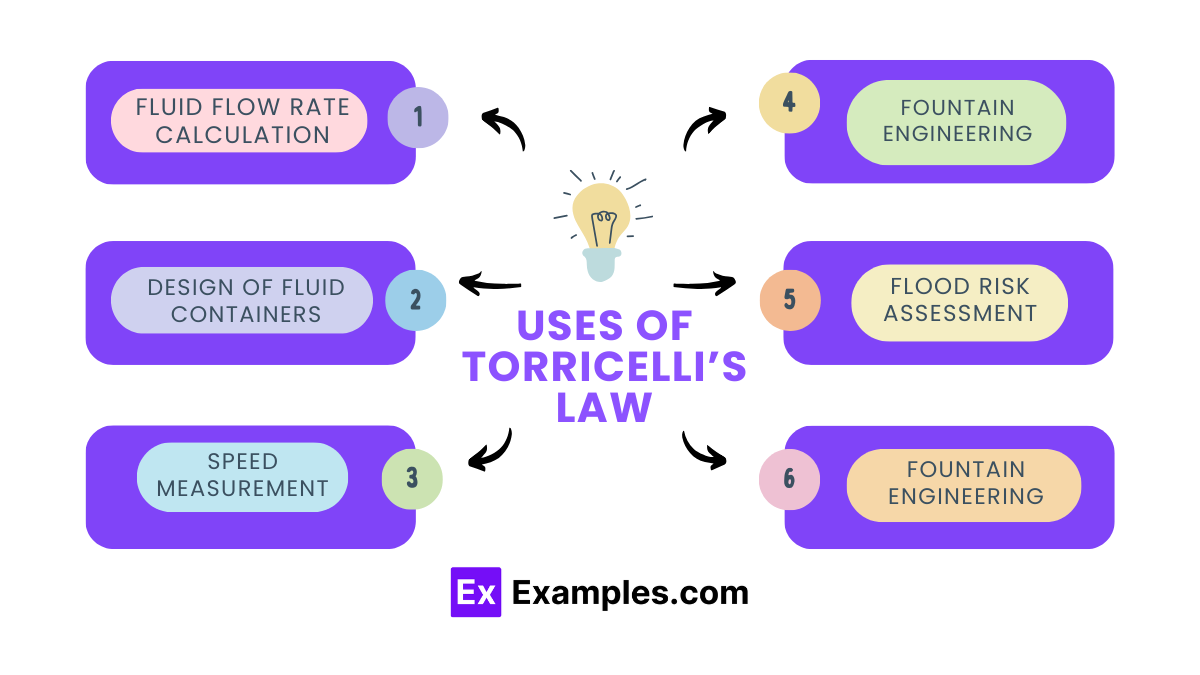Torricelli’s Law
Torricelli’s Law in physics describes the speed of fluid flowing out of an orifice or opening due to gravity. This law, derived from the principles of fluid dynamics, states that the speed (𝑣) of efflux of a fluid under the influence of gravity
What is Torricelli’s Law?
Torricelli’s Law Formula
The formula for Torricelli’s Law is:
where:
- 𝑣: Speed of the fluid exiting the orifice (in meters per second, m/s)
- 𝑔: Acceleration due to gravity (approximately 9.8 m/s² on the surface of the Earth)
- ℎ: Height of the fluid above the orifice (in meters, m)
This formula demonstrates that the speed of the fluid flow depends on the square root of the product of twice the gravitational acceleration and the height of the fluid above the opening.
Torricelli’s Law Derivation
To understand the derivation of Torricelli’s Law in a simpler way, let’s follow these steps:
Imagine a container with a small hole near its bottom filled with water. The water flows out of this hole, and we’re interested in finding out how fast it flows.
Using Energy Concepts
We use the concept of potential and kinetic energy to derive the speed. At the water surface (top of the tank), the water has potential energy because of its height above the hole.
Conservation of Energy
According to the law of conservation of energy, the total energy remains constant. As water falls towards the hole, its potential energy converts to kinetic energy, increasing its speed.
Assume the surface of the water is much larger than the hole, so the speed of water at the surface is negligible. Assume the pressure of the water is equal at the surface and at the hole, as they are both exposed to the atmosphere.
Deriving the Formula
Since potential energy (𝑃𝐸) converts to kinetic energy (𝐾𝐸): 𝑃𝐸=𝐾𝐸 𝑚𝑔ℎ=1/2𝑚𝑣²
- 𝑚: mass of the water
- g: gravitational acceleration (9.8 m/s²)
- h: height of the water above the hole
- v: speed of the water coming out of the hole
Canceling mass 𝑚 on both sides: 𝑔ℎ=1/2𝑣²
Solve for the Speed
Multiply both sides by 2 to isolate 𝑣²:2𝑔ℎ=𝑣² Take the square root of both sides to solve for 𝑣: 𝑣=√2𝑔ℎ This is Torricelli’s Law, showing that the speed of water flowing out of a hole depends on the height of the water above the hole.
Uses of Torricelli’s Law

- Fluid Flow Rate Calculation: Torricelli’s Law helps calculate the rate at which fluid flows out of a container, crucial for designing systems like tanks and reservoirs.
- Design of Fluid Containers: Engineers use this principle to design containers and systems that manage fluid flow based on desired exit velocities.
- Flow Speed Measurement: By applying Torricelli’s Law, one can estimate the speed of fluids exiting a container, which is useful in various scientific and engineering experiments.
- Fountain Engineering: Designers use this law to determine the speed and height of water jets in fountains.
- Flood Risk Assessment: Torricelli’s Law helps assess the outflow speed of water in flood scenarios. Aiding in flood modeling and risk analysis.
- Fountain Engineering: The law helps fountain designers predict how high and fast the water will jet out of the nozzles based on the pressure and water height in the system.
Examples for Torricelli’s Law
- Water Tank Drainage:
In a water tank with an opening at the bottom, Torricelli’s Law helps calculate the exit speed of water based on its height. For example, if the water level is 4 meters, the exit speed is about 8.9 m/s. - Fountain Design:
To ensure a fountain’s water jets reach a specific height, engineers use Torricelli’s Law to calculate the needed speed and pressure. For a 5-meter high jet, they use the law to find the required speed. - Pipeline Flow Measurement:
By using the law on an open tank connected to a pipeline, the speed and flow rate of fluids can be measured and optimized for production. - Irrigation System Design:
Torricelli’s Law helps design irrigation systems by calculating the flow speed through outlets, ensuring efficient water distribution. - Flood Modeling:
The law estimates water flow speed from higher elevations to lower ground, improving flood modeling and control measures.
FAQ’S
What is Torricelli’s experiment class 11?
Torricelli’s experiment, commonly taught in Class 11, demonstrates fluid pressure principles. By creating a vacuum with mercury, it shows how atmospheric pressure influences fluid columns in tubes.
What is efflux in Torricelli’s law?
In Torricelli’s Law, efflux refers to the fluid flowing out of an orifice due to gravity. Therefore, its speed depends on the height of the fluid above the opening.
How did Torricelli’s experiment work?
To demonstrate atmospheric pressure, Torricelli filled a tube with mercury, inverted it into a dish, and observed the mercury column. The resulting height represented atmospheric pressure.



